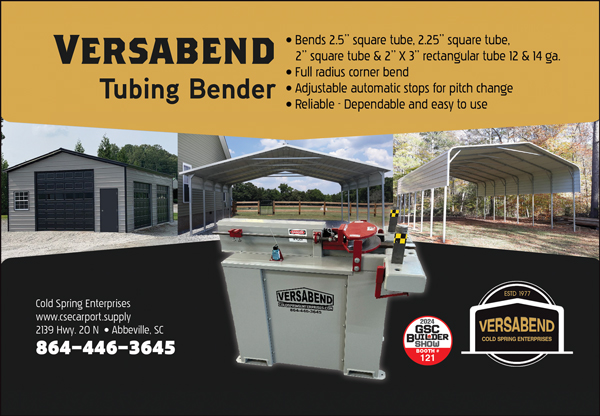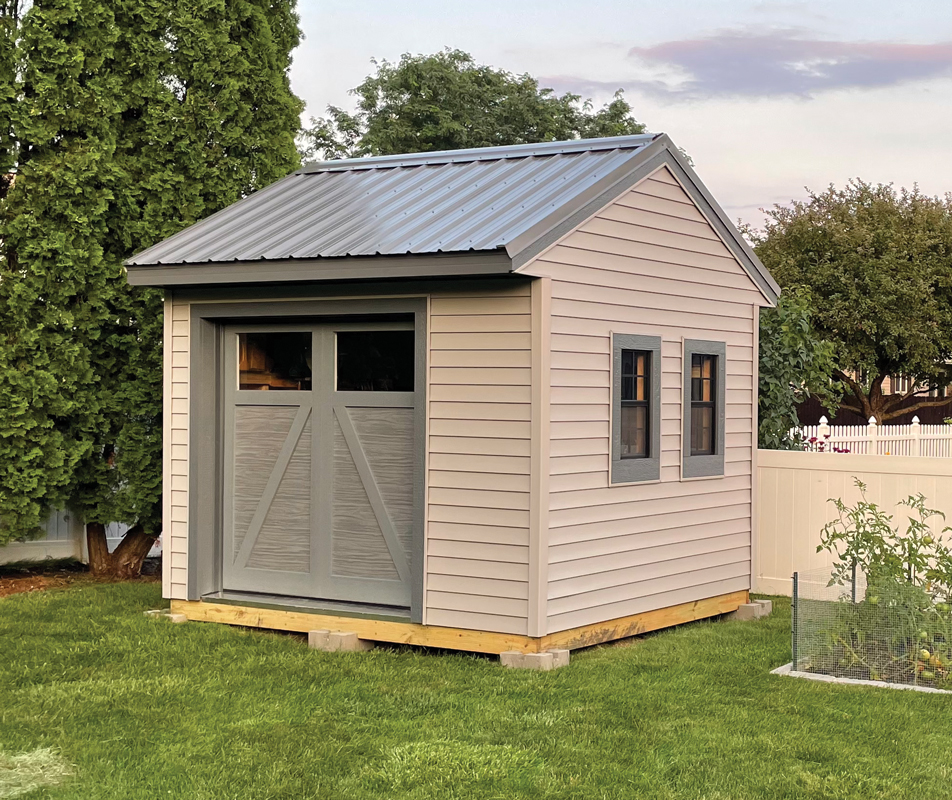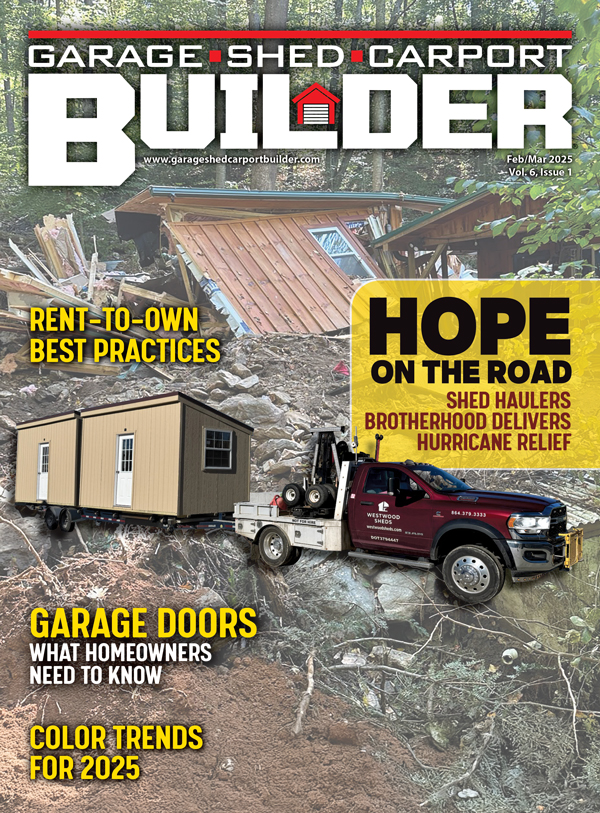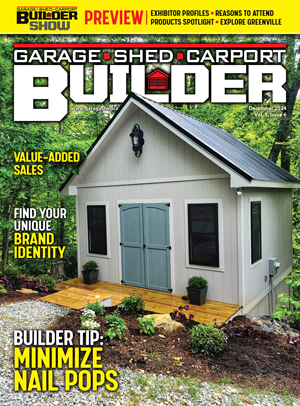Is adding completed office units to your product line-up the right move for your shed business?
by Carol J. Alexander
In 2014, Anthony Taylor-Weber needed office space for his home inspection business. He wanted to work from home but with a growing family, space was a premium. So, he and his wife, Jamie, priced home renovations and additions. All options were too costly.
Their predicament led to the birth of a new business for the Taylor-Webers—Outdoor Office in Sherwood, Oregon.
“I read a study that said by the year 2025 30-million people would work from home full-time,” says Anthony. “That proved to me that my business model was a viable one.”
With his construction background and Jamie’s eye for design, the Taylor-Webers created a product that rapidly grew in popularity. Thinking it would take years to get this side gig off the ground, they started building offices in their own garage. That lasted six months before they outgrew the space. They’ve moved to larger facilities three times since then, roughly doubling their footprint each time.
“We started wanting to do six buildings per year,” Anthony says. “But the first three weeks of 2020, we signed contracts for three buildings and by the first of March were on pace to build two per month.”
Then, Covid-19 hit.
“The facility we moved into this summer was five times that of our previous one,” Anthony says, “and now, we’ve outgrown it.”
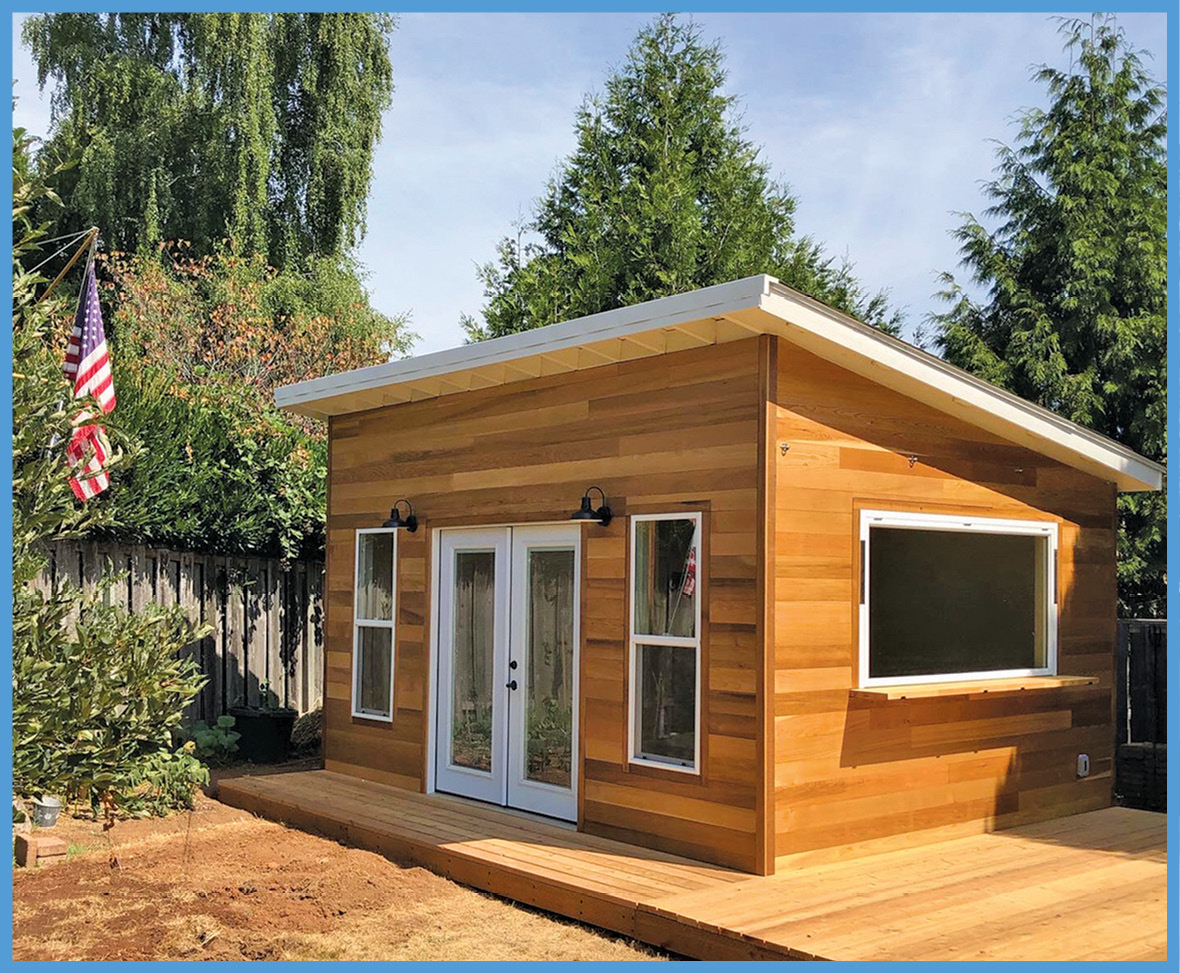
When you’re selling a $30,000 product, the client has a certain level of expectation.
Photo courtesy of Outdoor Office
Another Pre-Covid Backyard Office Builder
In 2010, home builder Jason Ellis and his father, Jeff Ellis, started building backyard studios as a way to pivot their construction business after the 2008 recession. Their studios and offices morphed into full-blown accessory dwelling units (known as ADU’s) for those who wanted in-law suites without remodeling their home. Their new business, Kanga Room Systems in Waco, Texas, offers pre-fabricated kits homeowners can put together themselves. Or, Kanga Room will assemble them for you.
Already a thriving business, Kanga Room has sold “a bunch of kits” since Covid-19. And, according to Jason, they’ve done nothing to instigate the increased sales. Obviously, the need has increased demand.
What Covid-19 Has Done To The Work From Home Space
Several months into the pandemic, Global Workplace Analytics (GWA) published survey findings of almost 3000 participants worldwide regarding their work from home habits. In their “Global Work From Home Experience Survey Report,” 31 percent of respondents said they worked from home on a regular basis prior to Covid-19 and 88 percent are working from home on a regular basis currently. That’s a 57 percent increase in work from home employees around the globe. And in a June 2020 article in Stanford News, Nicholas Bloom, professor of economics in Stanford’s School of Humanities and Sciences, states that in the U.S., “almost twice as many employees are working from home as at work.”
Benefits Of A Backyard Home Office
Forced home to work, many workers found themselves trying to perform from the kitchen table. Smack in the middle of chaos. When reality proved this work from home arrangement wasn’t going away, workers improvised in a variety of ways. Of those ways, only the backyard home office offers many of the same benefits of “going to work.”
Privacy—A backyard home office gives your customers the quiet and space they need for virtual meetings without a kid’s head popping up or the dog barking. And, if a customer works with sensitive information, data safe glass could be an upsell.
Separation—When you have a dedicated space for work, where you can shut the door and “go home,” it helps your brain to relax and focus on the family.
Organization—With a backyard office, a customer’s work doesn’t become mixed in with their child’s schoolwork or the family mail when it’s dropped on the table.
Jumping on the Bandwagon
Seeing the need for dedicated work space in their communities has led some shed builders to try and capitalize on the demand and add backyard offices to their product line-up. One such company is Ulrich Barn Builders in Harrisonburg, Virginia.
“Actually,” says Paul Yates, design consultant with Ulrich, “it was an idea we bounced around pre-Covid but the virus brought it back to the front burner and we’ve been leaning into it pretty heavily.”
When the demand for offices increased last spring, the leadership team at Ulrich started discussing the possibilities. They surveyed furloughed workers in their target markets to gauge interest. When they saw the results, they began the design phase.
“It did take a bit of time to get the design figured out,” says Paul. As, according to him, the company adapted an existing product to accommodate the need.
“There were some challenges from the zoning and building permit side of things,” Paul says. “For example, I was told yesterday we’re going to limit our completed unit to one size, ten-by-twelve, to make things easier.”
Ulrich launched their backyard home office in August. They weren’t willing to disclose sales numbers but Paul did give some insight.
“At first, customers didn’t want to commit because they thought it would blow over,” he says. “Now, people are actually relocating out of the cities because they see this as more long-term. They are driving up the demand.”

The year 2020 saw serious growth in the home office market. Outdoor Office of Sherwood, Oregon, experienced the growth first hand. Photo courtesy of Outdoor Office
Advice From The Pioneers
If you’re thinking of pivoting your shed manufacturing company to meet the backyard home office needs since Covid, Jason and Anthony have a few words of advice.
Do Your Research
“Get the data for your target market on work-from-home workers before you make any decision,” says Anthony. He stresses that some rural markets, where the industry landscape is manufacturing, may not have the demand for home offices because those workers can’t work from home. But if your target market is an urban or suburban setting, the data will let you know if the demand is there.
Also, ask your client base what they want. Some customers may want to buy the shed and do the work themselves, says Jason. “It’s about 50/50 for us, the number of customers who want a turnkey building versus doing it themselves.”
Design Your Model
“You need to ask, ‘What changes need to be made to my existing product?’” says Jason. After all, he says a backyard home office is not a dressed-up shed. Besides the obvious electrical and HVAC package, the structure will need some updates. Floor joists and wall studs must be two-by-six construction to accommodate insulation. Roof rafters need joists for creating flat ceilings. You need to install blocking for nailing up drywall. And, ceiling heights need to be higher.
“You’ll need to follow residential building standards to hold the value and get approved by local ordinances,” says Anthony. “Completed units are an alternative to additions and remodels,” he says. “They’re not a shed.”
Jason agrees. “There’s a fine line in design,” he says, “that makes a building look like it was made for its use, and that is was a converted shed.”
Because, in addition to the studs, floor, roof, and siding, a backyard home office includes the cost of an electrician, the electrical inspector, an HVAC unit, upgraded doors and windows, and any other options you want to include. “Your design needs to be noticeably different from your shed,” says Jason, “so customers will pay for these upgrades.”
Anthony agrees. “When you’re selling a $30,000 product, the client has a certain level of expectation.”
Another thing Anthony says to consider when designing your backyard home office is the weight of the unit. If you’re selling completed units to deliver, they can’t exceed the weight limits for your delivery rigs.
Crunch The Numbers
Just because a pivot is a good idea, doesn’t mean it’s a good idea for your business. Anthony stresses shed builders ask themselves, “What’s this investment going to require?”
Once you design your unit, a launch is no small feat. Website copy needs to be added, point-of-sale documents printed, and advertising campaigns created. Unless your company employs a marketing team with content writers, this is something you’ll need to hire out.
Also, building completed units require either hiring skilled employees or subcontractors for things like electrical work. Some states require you have a general contractor’s license to hire subcontractors—a requirement many shed builders don’t have. And, Anthony muses that in today’s building climate, with a lack of skilled workers, few electricians will subcontract a $2000 job wiring a shed when they can get a $50,000 job wiring an entire home.
The Future Of Working From Home
As Paul says, customers were reluctant to commit at first because they thought the pandemic would blow over. But it looks like it’s here for at least another year. What does that bode for the future of working from home?
According to the GWA survey, the work-from-home trend will continue post-Covid and become part of our new normal. To what extent, though, remains to be seen.
All things considered, Anthony intimates that some shed builders are better off focusing on improving their product rather than spreading themselves thin to produce something new. “Don’t get caught up in the money,” he says, “and lose sight of your why.”
He recommends taking the time to work with your clients, put their interests first, and provide a solution to their problem. GSCB
Carol J. Alexander writes feature articles, website copy, case studies, and more for the home remodeling and building industry. Notable clients include This Old House, Chicago Faucets, and BobVila. She lives in the beautiful Shenandoah Valley of Virginia.



